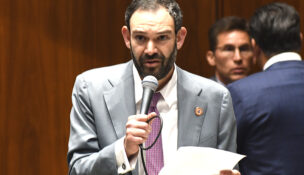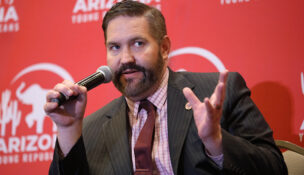Arizona closer to adopting stricter auto emission standards
Arizona Capitol Reports Staff//May 25, 2007//[read_meter]
Arizona closer to adopting stricter auto emission standards
Arizona Capitol Reports Staff//May 25, 2007//[read_meter]
Arizona stands poised to adopt stricter auto pollution standards, following California’s lead.
But California first must get a federal waiver from the U.S. Environmental Protection Agency, said Diane Brown of the Arizona Public Interest Research Group (PIRG), a nonprofit organization that advocates for environmental and social reform.
The waiver would allow California to establish tougher auto-emission standards than those set by the EPA. In particular, California’s proposed rules would regulate greenhouse gases from auto tailpipes – something that the federal government does not do.
Greenhouse gases such as carbon dioxide are regarded as a major contributor to global warming.
Under the federal Clean Air Act, only California can get a special waiver for stricter emission standards — as California regulated auto emissions before the adoption of the Clean Air Act in 1970. But other states can follow suit, once a waiver has been granted. California applied for the current waiver some 18 months ago.
It’s a waiver that PIRG and more than a dozen states have been pushing for.
“The federal government needs to grant states the ability to clean up pollution from automobiles,” said Diane Brown of the Arizona Public Interest Research Group.
If California gets the waiver, 11 other states are ready to adopt that state’s stricter standards.
Six other states, including Arizona, are considering California standards, Arizona PIRG said in a news release.
Lori Faeth, the governor’s senior policy adviser for environmental issues, said Arizona plans to fall in line with California. It’s a matter of waiting on the waiver.
“That’s when Arizona can begin to take action to implement a program,” Faeth said.
Gov. Janet Napolitano put Arizona in the running for regulating greenhouse gases from tailpipes with a 2006 executive order, which charges the Arizona Department of Environmental Quality with implementing a “Clean Car Program.”
DEQ’s Clean Car rules will be based on California standards, said DEQ spokesman Cortland Coleman.
“We are working on this but I don’t have draft rules or anything at this point,” Coleman said.
The executive order followed recommendations from the Climate Change Advisory Group, created by Napolitano in 2005. The group was made up of representatives from government, agriculture, utilities, businesses and the environmental community.
One recommendation was that Arizona cut greenhouse-gas emissions to 2000 levels by 2020.
As for the waiver, California officials made a case for it before an EPA panel in Washington on May 22.
The New York Times reported that California has a “goal of reducing greenhouse gas production from vehicles by 30 percent by 2016.”
Brown added that California and the 11 other states committed to follow its lead make up a third of the auto market. Most of those states are in the East, but the group includes Washington and Oregon. A PIRG news release stated that the stricter standards in these 12 states would cut yearly greenhouse-gas tailpipe emissions more than 400 million tons by 2020.
Equivalent of taking 74 million cars off the road
The PIRG news release said that it was “the equivalent of taking 74 million of today’s cars off the road for an entire year.”
If Arizona adopts California standards — along with the five other states leaning toward them — CO2 auto emissions could be cut by an additional 158 million tons a year by 2020, PIRG said.
The stricter standards also would demand better fuel economy and save motorists money at the pump, Brown said.
A representative for automobile manufacturers, however, told the EPA panel that implementing California rules in a patchwork fashion could make cars more expensive, smaller, less safe and cost jobs.
Steven Douglas said the EPA should reject California’s waiver in favor of gradual adoption of national standards, The New York Times reported May 23.
According other news accounts, California Gov. Arnold Schwarzenegger has threatened to sue the EPA if the waiver isn’t granted by Oct. 25.
Brown of Arizona PIRG said EPA waivers for California are not rare events. The agency has granted 50 of them in the past four decades.

















